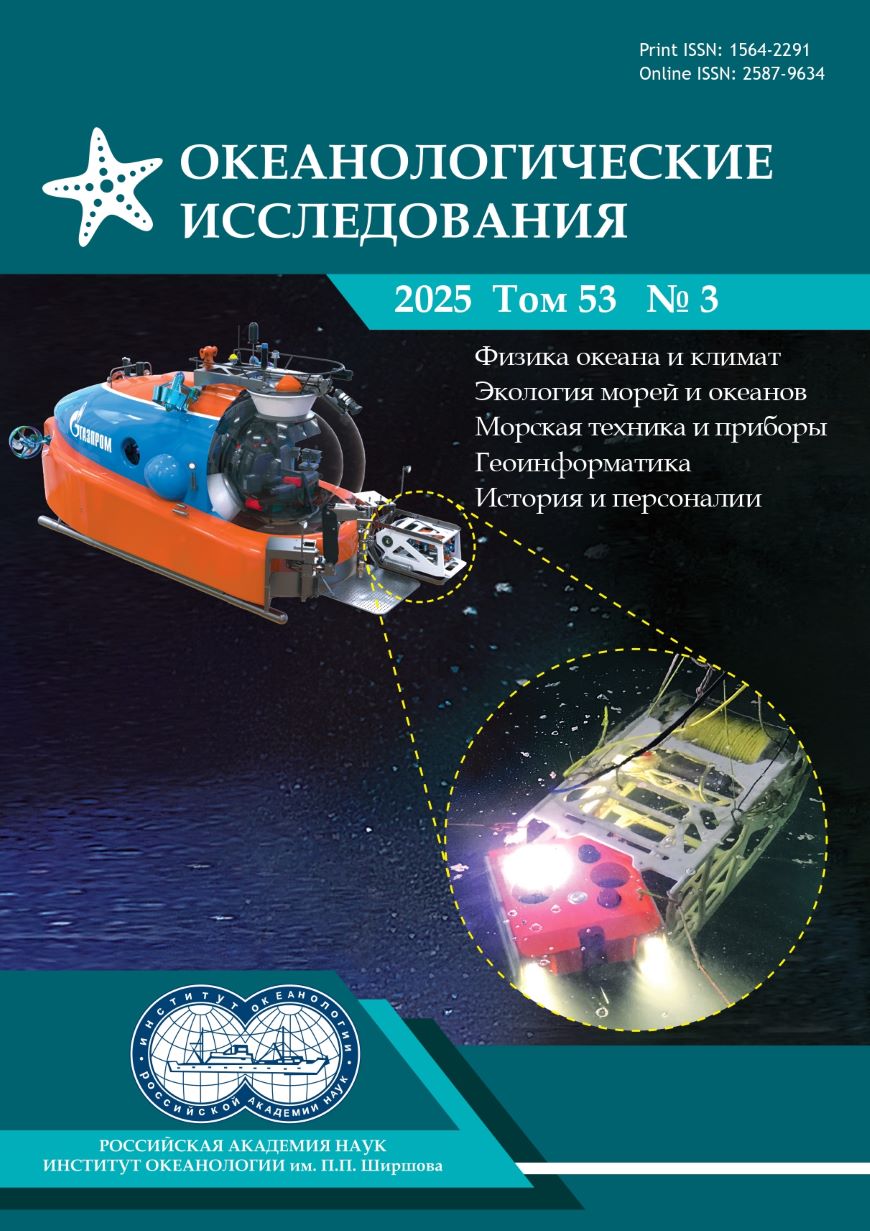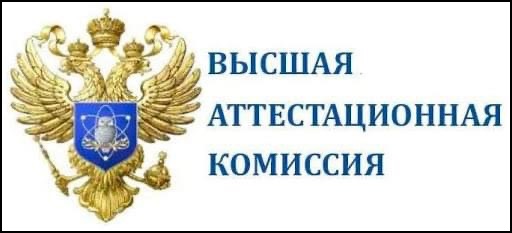ГЕТЕРОТРОФНЫЕ МИКРООРГАНИЗМЫ И ВИРУСЫ В ПРИБРЕЖНЫХ ВОДАХ АРХИПЕЛАГА СЕВЕРНАЯ ЗЕМЛЯ (АРКТИКА) В ПЕРИОД ТАЯНИЯ ЛЕДНИКОВ
Аннотация
Впервые получены количественные данные о бактериях, гетеротрофных нанофлагеллятах и вирусах в прибрежных водах архипелага Северная Земля. Исследования проводили в августе–сентябре 2019 г. в рейсе НИС «Профессор Молчанов». Численность бактерий (NВ), гетеротрофных нанофлагеллят (NF) и свободных вирусов (NVF) изменялась в широких пределах: соответственно (1.0–9.1) × 105 кл. мл−1, (84–502) кл. мл−1, (3.5–74.9) × 105 вир. мл−1. В исследованных водах обнаружены положительная корреляция между NВ и температурой воды (R = 0.69, n = 30, p < 0.05) и отрицательная корреляция между NВ и соленостью воды (R = −0.67, n = 30, p < 0.05). Между величинами NВ и NF наблюдалась сильная положительная корреляция: R = 0.86, n = 30, p < 0.05. Частота видимых инфицированных бактерий (FVIC) и вирус-индуцированная смертность бактерий (VMB) менялись от 0.7 до 3.9 % NВ и от 5.3 до 39.2 % продукции бактерий. Величины FVIC и VMB в прибрежных водах архипелага, в среднем, оказались существенно выше таковых в открытых водах Карского моря и моря Лаптевых. Показано, что поступление вместе с ледниковым стоком большого количества взвеси снижает смертность бактерий, вызванную вирусным лизисом, поскольку значительное количество вирусных частиц адсорбируется на частицах взвеси и теряет активность.
Литература
- Венгер М. П. Бактериопланктон северо-восточной части Баренцева моря // Вестник Южного Научного центра РАН. 2011. Т. 7. № 4. С. 55–60.
- Венгер М. П., Копылов А. И., Заботкина Е. А., Макаревич П. Р. Влияние вирусов на бактериопланктон открытой и прибрежной части Баренцева моря // Биология моря. 2016. Т. 42. № 1. С. 19–26.
- Венгер М. П., Широколобова Т. И., Максимовская Т. М., Болтенкова М. А., Ващенко А. В. Компоненты микробной пищевой сети в пелагиали фьордов о. Западный Шпицберген в современных климатических условиях // Труды КНЦ. Сер. Ест. и гум. науки. 2024. Т. 3. № 3. С. 23–37. https://doi.org/10.37614/2949-1185.2024.3.3.003.
- Косолапова Н. Г., Косолапов Д. Б., Копылов А. И., Романенко А. В. Гетеротрофные нанофлагелляты в пелагиали и донных отложениях восточной части моря Лаптевых // Океанология. 2019. Т. 59. № 6. С. 974–956. https://doi.org/10.31857/S0030-1574596974-986.
- Муравьев А. Я., Чернов Р. А. Прорыв ледниково-подпрудного озера Спартаковское и изменения выводного ледника купола Семенова-Тян-Шанского в 2021 г. (Северная Земля) // Лед и Снег. 2023. Т. 63. № 1. С. 17–32. https://doi.org/10.31857/S20076673423010118.
- Сажин А. Ф., Романова Н. Д., Копылов А. И., Романенко А. В., Заботкина Е. А. Гетеротрофный нано- и микропланктон Карского моря в осенний период // Океанология. 2023. Т. 63. № 2. С. 243–254. https://doi.org/10.31857/S0030157423020119.
- Хромова Т. Е., Носенко Г. А., Глазовский А. Ф., Муравьев А. Я., Никитин С. А., Лаврентьев И. И. Ледники и Ледниковые покровы. Новый каталог ледников России по спутниковым данным (2016–2019) // Лед и Снег. 2021. Т. 61. № 3. С. 341–358. https://doi.org/10.31857/S207667342030093.
- Azam F. Microbial control of oceanic carbon flux: The plot thickens // Science. 1998. Vol. 28. P. 694–696. https://doi.org/10.1126/science.280.5364.694.
- Binder B. Reconsidering the relationship between virally induced bacterial mortality and frequency of infected cells // Aquatic Microbial Ecology. 1999. Vol. 18. P. 207−215. https://doi.org/10.3354/ame018207.
- Bintanja R., Andry O. Towards a Rain-Dominated Arctic // Nature Climate Change. 2017. Vol. 7. P. 263. https://doi.org/10.1038/nclimate3240.
- Boras J. A., Sala M. M., Arrieta J. M., Sà E. L., Felipe J., Agustí S., Duarte C. M., Vaqué D. Effect of ice melting on bacterial carbon fluxes channelled by viruses and protists in the Arctic Ocean // Polar Biology. 2010. Vol. 33. P. 1695–1707. https://doi.org/10.1007/s00300‐010‐0798‐8.
- Børsheim K. Y., Bratbak G. Cell volume to carbon conversion factors for bacterivorous Monas sp. enriched from seawater // Marine Ecology Progress Series. 1987. Vol. 36. P. 171−175. https://doi.org/10.3354/meps036171.
- Caron D. A. Technique for enumeration of heterotrophic and phototrophic nanoplankton, using epifluorescence microscopy and comparison with other procedures // Applied Environmental Microbiology. 1983. Vol. 46. No. 2. P. 491−498. PMID: 16346372.
- Caruso G., Azzaro M., Caroppo C., Decembrini F., Monticelli L. S., Leonardi M., Maimone G., Zaccone R., La Ferla R. Microbial community and its potential as descriptor of environmental status // ICES. Journal of Marine Science. 2016. Vol. 73. P. 2174–2177. https://doi.org/10.1093/icesjms/fsw101.
- Danovaro R., Middelboe M. Separation of free virus particles from sediments in aquatic systems. In: S. Wilhelm, M. Weinbauer, C. Suttle (Eds.). Manual of Aquatic Viral Ecology. ASLO, 2010. P. 74–81. https://doi.org/10.4319/mave.2010.978-0-9845591-0-7.74.
- De Corte D., Sintes E., Yokokawa T., Herndl G. J. Changes in viral and bacterial communities during the ice‐melting season in the coastal Arctic (Kongsfjorden, Ny‐Ålesund) // Environmental Microbiology. 2011. Vol. 13. P. 1827–1841. https://doi.org/10.1111/j.1462-2920.2011.02497.x.
- Fenchel T. Ecology of heterotrophic microflagellates. II. Bioenergetics and growth // Marine Ecology Progress Series. 1982. Vol. 8. P. 225–231. https://doi.org/10.3354/meps008225.
- Heinrich H. Origin and consequences of cycling ice rafting in the northeast Atlantic Ocean during the past 130, 000 years // Quaternary Research. 1988. Vol. 29. No. 2. P. 142–152. https://doi.org/10.1016/0033-5894(88)90057-9.
- Hewson I., Fuhrman J. A. Viriobenthos production and virioplankton sorptive scavenging by suspended sediment particles in coastal and pelagic waters // Microbial Ecology. 2003. Vol. 46. P. 337–347. https://doi.org/10.1007/s00248-002-1041-0.
- Hill P. R., Nadeau O. C. Storm-dominated sedimentation on the inner shelf of the Canadian Beaufort Sea // The Journal of Sedimentary Research. 1989. Vol. 59. P. 455–468. https://doi.org/10.1306/212F8FC1-2824-11D7-8648000102C1865D.
- Kirchman D. L., Moran X., Ducklow H. Microbial growth in the polar oceans – role of temperature and potential impact of climate change // Nature Reviews Microbiology. 2009. Vol. 7. P. 451–459. https://doi.org/10.1038/nmicro2115.
- Krembs C., Eicken H., Junge K., Deming J. W. High concentrations of exopolymeric substances in Arctic winter sea ice: implications for the polar ocean carbon cycle and cryoprotection of diatoms // Deep Sea Research. Part I. Oceanographic Research Papers. 2002. Vol. 49. P. 2163–2181. https://doi.org/10.1016/S0967-0637(02)00122-X.
- Kopylov A. I., Zabotkina E. A., Romanenko A. V., Kosolapov D. B., Sazhin A. F. Viruses in the water column and the sediment of the eastern part of the Laptev Sea // Estuarine Coastal and Shelf Science. 2020. Vol. 242. e106836. https://doi.org/10.1016/j.ecss.2020.106836.
- Kopylov A. I., Zabotkina E. A., Sazhin A. F., Romanova N., Belyaev N., Drozdova A. Virioplankton and virus-induced mortality of prokaryotes in the Kara Sea (Arctic) in summer // PEERJ. 2023. Vol. 11. e154577. https://doi.org/10.7717/peerj.15457.
- Lara E., Arrieta J., Garcia-Zarandona J., Boras J., Duarte C. M., Agasti S., Vassmann P. F., Vaque D. Experimental evaluation of the warming effect on viral, bacterial and protistan commonities in two contrasting Arctic system // Aquatic Microbial Ecology. 2013. Vol. 10. P. 17–32. https://doi.org/10.3354/ame01636.
- Maat D. S., Visser R. J. W., Brussaard C. P. D. Virus removal by gracier-derived suspended fine sediment in the Arctic // Journal of Experimental Marine Biology and Ecology. 2019a. Vol. 521. e151227. https://10.1016/j.jembe.2019.151227.
- Maat D. S., Prins M. A., Brussaard C. P. D. Sediments from Arctic tide-water glaciers remove coastal marine viruses and delay host infection // Viruses. 2019b. Vol. 11. No. 2. e123. https://doi.org/10.3390/v11020123.
- Müller-Nilkas G., Herndl J. G. Dynamics of bacterioplankton during a phytoplankton bloom in the high Arctic waters of the Franz-Joseph Land archipelago // Aquatic Microbial Ecology. 1996. Vol. 11. P. 111–118. https://doi.org/10.3354/ame011111.
- Newell S. Y., Chrisrian R. R. Frequency of dividing cells as estimator of bacterial productivity // Applied Environmental Microbiology. 1981. Vol. 42. No. 1. P. 23–31. https//doi.org/10.1128/aem.42.1.23-31.
- Nguyen H. T., Lee Y. M., Hong J. K., Hong S., Chen M., Hur J. Climate Warming-driven changes in the flux of dissolved organic matter and its effects on bacterial communities in the Arctic Ocean: A review // Frontiers in Marine Science. 2022. Vol. 9. e968583. https://doi.org/103389/fmars.2022.968583.
- Norland S. The relationship between biomass and volume of bacteria // Handbook of Methods in Aquatic Microbial Ecology / Kemp P. F., Cole J. J., Sherr B. F., Sherr E. B. (Eds.). Lewis Publisher, Boca Raton. 1993. P. 303–308. https://doi.org/10.1201/9780203752746-36.
- Pfirman S. L., Eicken H., Bauch D., Weeks W. F. The potential transport of pollutants by Arctic sea ice // Science of The Total Environment. 1995. Vol. 159. P. 129–146. https://doi.org/10.1016/0048-9697(95)04174-Y.
- Pomeroy L. R., Macko S. A., Ostrom P. H., Dumpphy J. The microbial food web in Arctic seawater: concentration of dissolved free amino acids and bacterial abundance and activity in Arctic Ocean and in Resolute Passage // Marine Ecology Progress Series. 1990. Vol. 61. P. 31–40.
- Porter K. G., Feig Y. S. The use DAPI for identifying and counting of aquatic microflora // Limnology and Oceanography. 1980. Vol. 25. No. 5. P. 943−948. https://doi.org/10.4319/lo.1980.25.5.0943.
- Rokkan I. K., Seuthe L. Seasonal microbial processes in a high-latitude fjord (Kongsfjorden, Svalbard): 1. Heterotrophic bacteria, picoplankton and nanoflagellates // Polar Biology. 2011. Vol. 34. P. 731−749. https://doi.org/10.1007/s00300-010-0929-2.
- Sarmento H., Montoya J. M., Vazquez-Dominguez E., Vaque D., Gazol J. M. Warming effects on marine microbial food web processes: How for can we go when it comes to predictions? // Philosophical Transactions of the Royal Society B. Biological sciences. 2010. Vol. 365. P. 2137−2149. https://doi.org/10.1098/rstb.2010.0045.
- Sherr E. B., Sherr B. F., Fessenden L. Heterotropic protists in the central Arctic Ocean // Deep Sea Research. 1997. Vol. 44. P. 1665−1682. https://doi.org/10.1016/S0967-0645(97)00050-7.
- Sommaruga R. When glaciers and ice sheets melt: Consequences for planktonic organisms // Journal of Plankton Research. 2015. Vol. 37. P. 509–518. https://doi.org/10.1093/plankt/fbv027.
- Steward G. F., Fandino L. B., Hollibaugh J. T., Whitledge T. E., Azam F. Microbial biomass and viral infections of heterotrophic prokaryotes in the sub-surface layer of the central Arctic Ocean // Deep Sea Research. Part I. Oceanographic Research Papers. 2007. Vol. 54. P. 1744−1757. https://doi.org/10.1016/j.dsr.2007.04.019.
- Suttle C. A. Enumeration and isolation of virus // Handbook of Methods in Aquatic Microbial Ecology. 1st Ed. / Kemp P. F., Cole J. J., Sherr B. F., Sherr E. B. (Eds.). Lewis Publisher: Boca Raton, 1993. P. 121−134.
- Svendsen H., Beszczynska-Møller A., Hagen J. O., Lefauconnier B., Tverberg V., Gerland S., Børre Ørbæk J., Bischof K., Papucci C., Zajaczkowski M., Azzolini R., Bruland O., Wiencke C., Winther J.-G., Dallmann W. The physical environment of Kongsfjorden–Krossfjorden, an Arctic fjord system in Svalbard // Polar Research. 2002. Vol. 21. P. 133–166. https://doi.org/10.3402/polar.v21i1.6479.
- Thomas D. N., Dieckmann G. S. Antarctic sea ice – a habitat for extremophiles // Science. 2002. Vol. 295. P. 641–644. https://doi.org/10.1126/science.1063391.
- Vaque D., Lara E., Arrieta J. M., Holding J., Sa E. L., Hendriks I. E., Coello-Camba A., Alvarez M., Agusti S., Wassmann P. F., Duarte C. M. Warming and CO2 enhance Arctic heterotrophic microbial activity // Frontiers in Microbiology. 2019. Vol. 10. e494. https://doi.org/10.3389/fmicb.2019.00494.
- Wang G., Guo C., Luo W., Cai M., He J. The distribution of picoplankton and nanoplankton in Kongsfjorden, Svalbard during late summer 2006 // Polar Biology. 2009. Vol. 32. P. 1233–1238. https://doi.org/10.1007/s00300‐009‐0666‐6.
- Wells L. E., Deming J. W. Significance of bacterivory and viral lysis in bottom waters of Franklin Bay, Canadian Arctic, during winter // Aquatic Microbial Ecology. 2006. Vol. 43. P. 209−221. https://doi.org/10.3354/ame043209.
- Weinbauer M. G. Ecology of prokaryotic viruses // FEMS Microbiological Reviews. 2004. Vol. 28. No. 2. P. 127–181. https://doi.org/10.1016/j.femsre.2003.08.001.
- Weinbauer M. G., Bettarel Y., Cattaneo R., Luef B., Maier C., Motegi C., Peduzzi P., Mari X. Viral ecology of organic and inorganic particles in aquatic systems: avenues for further research // Aquatic Microbial Ecology. 2009. Vol. 57. P. 321‒341. https://doi.org/10.3354/ame01363.
Передача авторских прав происходит на основании лицензионного договора между Автором и Федеральным государственным бюджетным учреждением науки Институт океанологии им. П.П. Ширшова Российской академии наук (ИО РАН)












